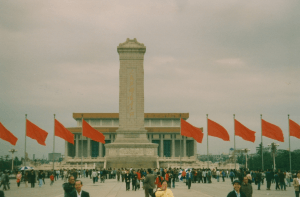The People’s Heroes Monument in Tiananmen Square is located in Beijing, China. The monument contains bas-reliefs around the base which represent important historical events throughout China’s history. Some of these events are the Wuchang Uprising, Nachang Uprising, Successful Crossing of the Yangtze River, May 30th Movement, etc. Although these bas-reliefs are beautiful pieces of art, they follow a common idea with the involvement of socialism in China. The monument “was a

Picture of The People’s Heroes Monument. Arian Zwegers 1995.
cultural production that addressed present political needs: affirming the legitimacy of the Chinese Communist Party (CCP), rewriting China’s turbulent history according to a carefully scripted Marxist text, and establishing the regime’s control over the nation’s collective memory”(Hung 2001, 1). The monument itself is a fascinating representation of the heroes who fought for national independence, however there is the political side of the monument which correlates to the ideology of socialism. The bas-reliefs are social realistic which is important to note while looking at the progress and transformation Mao Zedong established in China.
Each of the bas-reliefs with their own representation of an important event in China’s history can be carefully analyzed to the core of their meaning and the connection to socialism. It is important to acknowledge the monument’s purpose to honor those who have died, however what would there be a different perspective if part of its creation was to be a tool for the government? During the rise of the communists, “all artists in China were compelled to adhere to the party line of art. During the 1950s, this meant adopting Soviet-style “social realism,” an overtly didactic art style that promoted communist ideas”(Hyer and Billingsley 1).

Henry Tsang, Canada
From Beijing to Oka Installation, 1990.
I will analyze the monument as a whole, which includes the encryption of Mao’s hand writing at the top and the social realistic bas-reliefs surrounding the base. Upon finding the full underlying or obvious meanings of each element on the monument, in what ways do they tie with the socialistic ideologies Mao established in the progression and transformation of China?
Bibliography:
Hyer, Eric A., and Dodge Billingsley. “Art & Politics in Mao’s China.” Kennedy Center. https://kennedy.byu.edu/art-politics-in-maos-china/.
Hung, Chang-Tai. “Research Report. Revolutionary History in Stone: The Making of a Chinese National Monument.” The China Quarterly 166 (2001)


February 13, 2019 at 5:52 pm
This is very well done and helps with my project and how I want to do it. The historical background is very helpful and allows the person reading to understand why this is so important. The political background really helps with why this is so important to China, and its connection Mao. The explanation as to why the monument was constructed also helps a lot and the analysis allows for the reader to understand how important Mao and the people are. The multiple images of the monument as well as the close-ups help people see what you are talking about which is good.
February 13, 2019 at 6:28 pm
Great exhibition idea. I appreciate the point you’ve made about these works’ relation to socialist realism. I think it would be beneficial to go in depth about the history behind each bas relief. In what ways was the depiction accurate of historical events. In what ways was it made inaccurate in order to fit the Communist story? If these sculptures were to be made today, how would they be different?